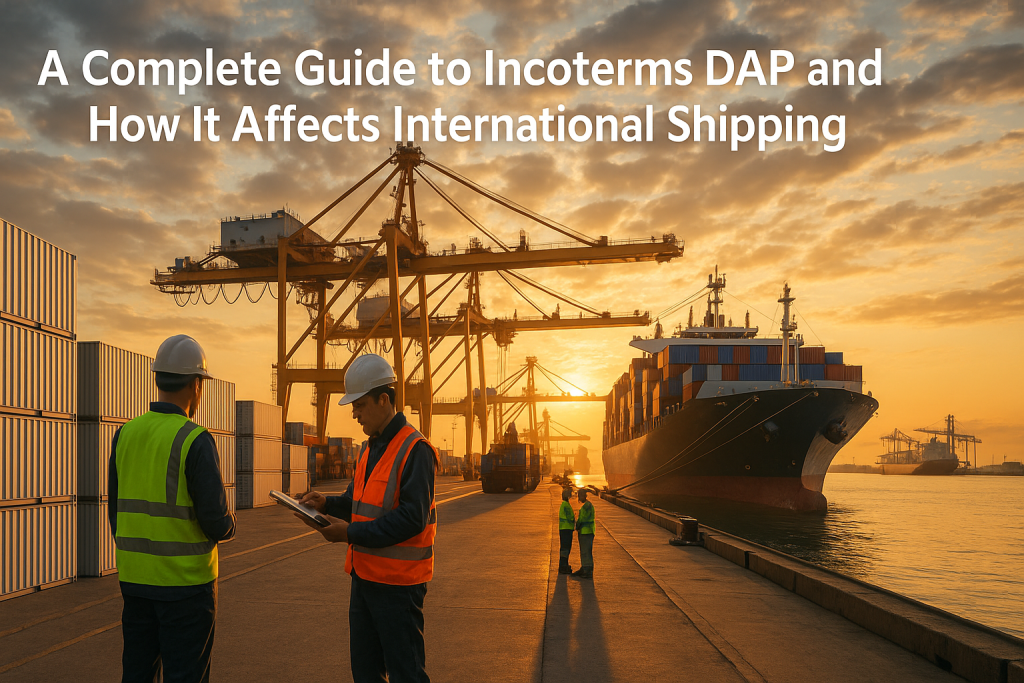International shipping involves a complex set of rules and responsibilities. One such rule is Incoterms DAP, which clearly defines when costs and risks shift between sellers and buyers. In fact, according to a 2020 survey, Incoterms DAP was the second most used Incoterm in international trade (allpointsatl.com). This popularity stems from the way Incoterms DAP simplifies transactions by placing most transport-related costs on the seller until goods reach the designated place.
In this guide, we will examine what Incoterms DAP is, how it compares to other trade terms, the main responsibilities of each party, and practical steps to implement it successfully. By understanding Incoterms DAP, your business can be better prepared to handle global sourcing, reduce disputes, and ensure a smoother international logistics process.
What Is Incoterms DAP?
Incoterms DAP (Delivered at Place) is a rule published by the International Chamber of Commerce (ICC). It requires the seller to bear all risks and costs associated with delivering goods to a named place of destination. Whether you are shipping by sea, air, or a multimodal transport route, Incoterms DAP can be applied to streamline your shipping process. According to academy.iccwbo.org, DAP can be used for any mode of transportation, making it a versatile choice for businesses that operate in multiple markets.
Under Incoterms DAP, the seller is responsible for:
- Arranging transportation from the departure point to the final destination.
- Covering costs such as export clearance fees and transit customs formalities.
- Bearing the risk of damage or loss of goods while in transit.
Once the goods arrive and are ready for unloading at the named place, the risk transfers to the buyer. In 2020, approximately 30% of international trade transactions used Incoterms DAP, demonstrating the growing preference for this term (allpointsatl.com).

Seller and Buyer Responsibilities Under Incoterms DAP
Incoterms DAP affects how responsibilities are divided between seller and buyer. Recent data indicates that about 70% of exporters use DAP to reduce potential risks in global trade (allpointsatl.com). Let’s break down each party’s duties:
Seller Responsibilities
- The seller must ensure the goods are properly packaged and labeled for international transportation.
- The seller manages export clearance and any required paperwork for shipping.
- Transport arrangements, including trucking, ocean freight, or air freight, are made by the seller.
- Transit insurance, if taken, often falls under the seller’s obligation until the goods reach the place of destination.
Buyer Responsibilities
- The buyer is responsible for import customs clearance, duties, and taxes unless otherwise agreed.
- Unloading costs generally fall to the buyer (academy.iccwbo.org). However, if the contract of carriage includes unloading, then the seller might cover it.
- If any additional local handling charges apply after the goods arrive, the buyer covers those costs.
Export Clearance and Customs
Under Incoterms DAP, exporters must handle certificates and authorizations for leaving their country. They also need to take care of transit customs formalities if the goods pass through multiple countries. If these processes are not clear, disputes can arise. In fact, about 25% of disputes in international trade stem from misunderstandings of terms like Incoterms DAP (allpointsatl.com).
Tips for Minimizing Risk
• Confirm who will bear unloading charges before sealing the contract.
• Use robust logistics platforms like Pazago and Shipping Solutions to manage required documentation.
• Ensure you have comprehensive insurance. While the seller holds risk during transit, having extra coverage can benefit both parties if errors occur.
Comparing Incoterms DAP with Other Shipping Terms
Incoterms DAP is not the only rule available. Other options like DDP (Delivered Duty Paid) and EXW (Ex Works) come to mind. Understanding the distinctions can help you find what’s best for each transaction:
• DAP vs. DDP
- Under DDP (Delivered Duty Paid), the seller also pays for import duties and taxes. This can be simpler for the buyer but places more obligations on the seller. In contrast, Incoterms DAP makes the buyer responsible for import duties and taxes.
- Businesses that want to avoid dealing with international taxation complexities often consider DDP, while others prefer DAP if they find local import processes more manageable.
• DAP vs. EXW
- EXW (Ex Works) pushes most responsibilities onto the buyer, from loading at the seller’s location to all subsequent shipping.
- When using EXW, the seller’s obligations end as soon as the goods are made available at the factory or warehouse. In DAP, on the other hand, the seller remains involved until goods reach the agreed destination.
Choosing the right Incoterm depends on factors like your shipping experience, trade lanes, and the level of control you desire over your logistics. DAP has gained popularity in e-commerce because it streamlines shipping for international buyers, who only need to handle customs at the arrival country.
Common Pitfalls and Best Practices for Incoterms DAP
Even though Incoterms DAP provides clarity, some common pitfalls can emerge. In a recent study, about one-fourth of disputes in international trade were related to misunderstanding Incoterms (allpointsatl.com). To avoid these hurdles, consider the following best practices.
Key Pitfalls
- Not specifying the exact place of delivery: Failing to name a precise location can create confusion about where risk transfers to the buyer.
- Overlooking local regulations: Some countries have special rules for unloading or import duties. Sellers and buyers who ignore these can face extra fees.
- Inadequate insurance coverage: Although the seller bears the risk during transit, not arranging proper coverage can leave both sides vulnerable.
Best Practices
- Use Digital Tools: Platforms like Pazago or Shipping Solutions can help you generate accurate documentation, reducing human error.
- Stay Informed: Regularly refer to ICC Academy or DHL’s Incoterms Guide to stay updated on any changes in priority shipping routes or documentation requirements.
- Deploy Checklists: Create a step-by-step checklist that details all responsibilities, from point of departure to customs clearances and final delivery.
- Train Your Team: Employee training around Incoterms DAP ensures everyone knows what to do, especially when unexpected shipping delays arise.
Implementing Incoterms DAP in Your Supply Chain
Whether you’re an importer, wholesaler, or a direct buyer for your business, Incoterms DAP can simplify your supply chain if executed correctly. It’s crucial for you to integrate this term with the right tools, training, and documentation. Powerhouses like DHL, FedEx, and Maersk often incorporate DAP in their shipping solutions, offering guidance to businesses seeking seamless global transactions.
Here’s a general roadmap for implementing Incoterms DAP:
- Define the Delivery Point: Choose a specific place where risk and cost will transfer from seller to buyer. This can be a port, warehouse, or distribution center.
- Draft a Comprehensive Contract: Spell out responsibilities in writing, including details on customs, insurance, and unloading fees. Platforms like Kuehne + Nagel’s shipping management tools can help formalize these specifics.
- Plan for Customs Clearance: Clarify who will manage import taxes and duties. According to tecex.com, confusion around duty payments is one of the leading causes of delivery delays.
- Track Your Shipment: Utilize real-time tracking solutions from FedEx or DHL to keep both parties informed of shipment progress. In today’s global economy, supply chain visibility is more critical than ever.
- Finalize Unloading Arrangements: If your contract specifies that the seller will handle unloading costs, be sure to confirm this with your carrier. Otherwise, the buyer should prepare for labor and equipment at destination.

Practical Tools and Resources for Incoterms DAP
Navigating Incoterms DAP can be less complex if you take advantage of the following software, organizations, and references:
- Pazago
Offers integrated logistics management, document handling, and financial solutions. Ideal for businesses that want a one-stop platform for global sourcing.
- Shipping Solutions
Specializes in export documentation and compliance. This resource helps you generate required forms accurately, reducing the risk of customs delays.
- ICC Academy
An online learning platform from the International Chamber of Commerce. Provides detailed modules on Incoterms DAP and other trade terms.
- DHL’s Incoterms Guide
Accessible resource explaining various Incoterms requirements, looking at both high-level concepts and detailed actions.
- Röhlig’s Incoterms 2020 Guide
Offers updated Incoterms guidance, including specific insights on DAP. Ensures you operate under the latest definitions and rules.
Recent trends show a shift toward greater use of DAP in e-commerce, further digitalization of trade documents, a heightened focus on supply chain visibility, and stronger emphasis on risk management. All these factors align well with Incoterms DAP’s goal of providing clarity on costs and risk transfer.
Conclusion
Incoterms DAP can be a powerful tool for businesses seeking to simplify complex international shipping. Data shows that approximately 70% of exporters favor DAP for reducing risks in global trade (allpointsatl.com). It is also adaptable across multiple transport modes, making it suitable for a wide range of products and industries. By understanding the responsibilities each side holds, using the right software solutions, and aligning your plans with recognized organizations like the International Chamber of Commerce, your business can successfully navigate Incoterms DAP.
As global commerce continues to evolve, proper use of Incoterms DAP builds trust and transparency between buyers and sellers. This, in turn, reduces misunderstandings, accelerates shipping timelines, and helps everyone in the supply chain know precisely where costs and risks lie. By following a step-by-step approach—covering everything from specifying the delivery point to choosing the right logistics software—you can leverage Incoterms DAP to enhance efficiency and gain a competitive advantage in international trade.

